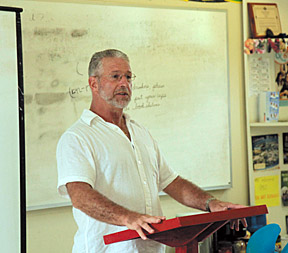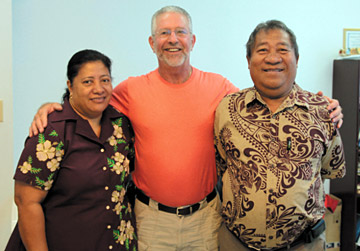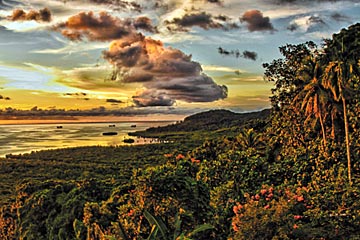The events of Sept. 11, 2001, changed my family in more ways than I could imagine. My daughter became driven with a need to serve and decided to join the National Guard in 2002.
I flew to Colorado and spent five days with her as she prepared to spend a year in that volatile, war-torn country. There was the pomp and ceremony at the Pepsi Arena in Denver, and then the heart-wrenching goodbyes at the Air Force base as we sent our young sons and daughters off to war. My daughter was capable, tough and committed. She knew why she was going and what she was going to do. I felt empty and concerned. That emptiness became an inspiration for me to find a way to serve.
Inspired to Serve
I returned home to New Jersey and composed a letter offering my 30 years of skills as a chiropractor to a few dozen governmental and non-governmental agencies (NGO). I was hoping to have a opportunity to serve in the hospital in Germany where our wounded soldiers were treated, but I never received a response. I did eventually receive a single response from an NGO, but it wasn't very encouraging. It simply stated, "We don't know how you can help."
 Dr. Marelli with a grateful recipient of chiropractic care.
Several months had passed when I received an e-mail from that same NGO. It was the director, John Schroer of Mahi-International. He said he was in New York City and wanted to have dinner with me. I agreed. I Googled Mahi-International and discovered that it was dedicated to improving the health and education of the people of Micronesia. I had no idea where Micronesia was, so the research began.
Dr. Marelli with a grateful recipient of chiropractic care.
Several months had passed when I received an e-mail from that same NGO. It was the director, John Schroer of Mahi-International. He said he was in New York City and wanted to have dinner with me. I agreed. I Googled Mahi-International and discovered that it was dedicated to improving the health and education of the people of Micronesia. I had no idea where Micronesia was, so the research began.
Micronesia is a sovereign island nation made up of four states: Yap, Chuuk, Kosrae and Pohnpei. It is located about 7 degrees above the equator in the western Pacific, about 2,000 miles southwest of Hawaii and about 2,000 miles northeast of Australia. The 607 islands occupy more than 1 million square miles of the Pacific Ocean. It became an American territory in 1949 when we claimed it from the occupying Japanese, and it ultimately became a sovereign state in 1986.
Armed with some information about Micronesia and Mahi-International, I met John Schroer for dinner in early December 2010. The first thing he said to me was that after he had mentioned to Dr. Elizabeth Keller, the minister of health, that a chiropractor wanted to come to the islands to serve, she was "jumping for joy" over the prospect of such a visit and asked him to arrange it.
John said that I would be the first chiropractor to ever serve in Micronesia, and he asked if I could spend a month on the island of Pohnpei and possibly reach out to serve some of the people of outer islands as well. I was both excited and grateful for the offer; after several days of pondering, I agreed to spend the month of August 2011 serving the people of Pohnpei under the auspices of Mahi-International.
I spent the next several months planning and researching the island culture. The most eye-opening pieces were tourist videos on YouTube. I was about to leave civilization as I knew it and travel several thousand miles to a western Pacific island that received 144 inches of rain a year and was settled over 3,000 years ago,
John Schroer knew nothing of chiropractic. He was attentive as I explained and then began to provide him with a constant flow of basic information to raise his awareness. We discussed purchasing a portable adjusting table with adjustable legs that could support 500 pounds. That table finally arrived after I retuned to N.J.
First Adjustments in Micronesia
I left on Aug. 6, 2011, set to return on Sept. 5. I took a direct 14-hour flight from Newark to Tokyo, then Tokyo to Guam, and then on to my final destination, Pohnpei. I was met at the airport by John Schroer, his wife, Kat, and their 3-year-old son, Kai. They brought me to my new residence just outside the city of Kolonia. I was staying with a contracted EMT instructor who was house-sitting for a couple on honeymoon in Europe. The house had a balcony that was perched high above a fantastic western panorama of the Pohnpei landscape. The setting was unbelievable.
 Dr. Marelli shares the philosophy of chiropractic before providing adjustments.
The next day began with an appointment with Dr. Keller, the minister of health, and her husband, Malik Keller, the mayor of Pingelap. It was a relaxed atmosphere and we discussed my agenda. The first two chiropractic adjustments given in Micronesia were given to Dr. Keller and her husband.
Dr. Marelli shares the philosophy of chiropractic before providing adjustments.
The next day began with an appointment with Dr. Keller, the minister of health, and her husband, Malik Keller, the mayor of Pingelap. It was a relaxed atmosphere and we discussed my agenda. The first two chiropractic adjustments given in Micronesia were given to Dr. Keller and her husband.
That meeting with the Kellers launched me into my first full day of work, which involved driving the entire perimeter of the island and assisting the Pohnpei Rotary Club in distributing book bags to 1st graders in all of the public schools. (By the way, I served as president of the Florham Park [N.J.] Rotary Club back in the mid-'80s.) This was a good day because I got to see the main city of Kolonia and the more rural parts of the entire island.
Day two was when my chiropractic adventure began. John had me scheduled for three talks that day and I couldn't wait to get started. The first group was comprised of teachers and missionaries from a Baptist church/school. The audience was English-speaking and numbered around 65 people.
The essence of every talk was simple. I only discussed the philosophy of chiropractic and left the science and art for them to experience. My first patient was the senior pastor; then everyone in attendance followed.
My second talk that morning was to a Catholic church group, but this time, the same talk required a translator. There were about 45 people in that group and following the senior pastor, everyone received an adjustment. By lunchtime I had already given over 100 adjustments. I was flying!
 Dr. Elizabeth Keller, Micronesia Minister of Health (left) and her husband, Malik Keller, mayor of Pingelap (right) were the first to be adjusted by Dr. Marelli.
Following lunch, I presented another translated talk to the Kapingamorangi villagers. These people came from the far reaches of the Micronesian territory to escape a several-year drought on their island. A large thatched-roof hut provided the stage for my talk. Chief Hendrich translated and then became the first patient; everyone else stood in line to receive their first adjustment. Stragglers who had wandered to the hut were instructed by the chief to sit in front of me and get an adjustment.
Dr. Elizabeth Keller, Micronesia Minister of Health (left) and her husband, Malik Keller, mayor of Pingelap (right) were the first to be adjusted by Dr. Marelli.
Following lunch, I presented another translated talk to the Kapingamorangi villagers. These people came from the far reaches of the Micronesian territory to escape a several-year drought on their island. A large thatched-roof hut provided the stage for my talk. Chief Hendrich translated and then became the first patient; everyone else stood in line to receive their first adjustment. Stragglers who had wandered to the hut were instructed by the chief to sit in front of me and get an adjustment.
I treated around 80 people in that village and nearly 200 people overall during my first working day on the island. It was like a dream. People were standing in line, submitting themselves with an unquestioned trust to a technique that was more akin to the care they received prior to the introduction of Western medicine.
Dr. Keller arranged for me to use a table in the physical therapy room at the state hospital. That became my base for treating patients. My schedule was announced on the radio every day and as I traveled to various clinics throughout the island. I was usually greeted by several dozen people who were awaiting my arrival. The clinics were equipped with MD exam tables that were too high and not suitable for my work. I decided to give a brief talk and adjust everyone as they sat.
Ultimately, all of the care was rendered from my room in the hospital. Every morning I arrived for work at 8:30 a.m. and 25 people were waiting for me. I would typically see around 60 people in the morning; break for lunch, then see another 45-50 in the afternoon. I was gleefully busy.
Outreach Efforts
Dr. Keller and I took a 1 1/2 hr. flight to the island of Pingelap, where I spent four days. This island was inhabited by around 160 villagers, had no fresh water, and no power. I slept and worked out of the island's clinic, which did have solar power that provided us with lights, a fan at night, and Wi-Fi for the villagers to Skype their relatives. Drinking water was replaced by coconut milk, and it was satisfying and delicious all the time. Showers and bathroom needs were supplied by captured rainwater driven by solar-powered pumps. The island provided all of the food the villagers needed: coconuts, mangos, fish, bananas, breadfruit, chickens and pigs.
 Western panorama of the Pohnpei landscape - the perfect setting for a mission trip.
Villagers of all ages wandered in and out of the clinic, many returning after their first adjustment. The back door of the clinic was the warm, crystal-clear waters of the Pacific. I was living in paradise. Living on Pingelap was the highlight of my trip. They were the most wonderful, gracious, caring, and generous people I had ever met in my life. The most unique feeling was the way they treated me. I was received as a family member who had just returned home. It was awe-inspiring.
Western panorama of the Pohnpei landscape - the perfect setting for a mission trip.
Villagers of all ages wandered in and out of the clinic, many returning after their first adjustment. The back door of the clinic was the warm, crystal-clear waters of the Pacific. I was living in paradise. Living on Pingelap was the highlight of my trip. They were the most wonderful, gracious, caring, and generous people I had ever met in my life. The most unique feeling was the way they treated me. I was received as a family member who had just returned home. It was awe-inspiring.
A similar experience occurred on another island I visited called Pakin. This one-day adventure started with 15 people and supplies packed into a 25-foot skiff traveling 30 miles in the open Pacific. Needless to say, they are skilled navigators because they used no instruments, and the vista was just water and sky for a good part of the trip.
We approached the island in low tide and had to negotiate a small channel in the coral reef 2 miles outside of the island. Several young men from the island motored out to assist us. We threw them a rope and they pulled us through the channel, walking barefoot on the coral reef. I don't have to tell you what that would have done to our feet. We were greeted with coconuts and settled in. Later, I gave a translated talk and again adjusted everyone in attendance.
A print announcement was made to all of the Micronesian islands about my arrival. A couple from Oregon were in Kosrae on a scuba vacation. The husband hurt himself, heard that I was in Pohnpei and flew in for care. That would be like someone flying from Chicago to New York for an adjustment. Five adjustments later, he flew away to finish his diving vacation.
The balance of my stay had me seeing patients in the state hospital. The volume remained constant and toward the end, the patients were bringing gifts to express their gratitude. I am determined to return to Pohnpei and create a chiropractic presence on the other three islands of Yap, Chuuk and Kosrea.
The Power of Volunteerism
In closing, I want to reflect on the impact this experience has had on my life. I had the opportunity to travel to an exotic location, be a pioneer for chiropractic, and lay the groundwork for future visits by fostering goodwill. I am now nurturing lifelong relationships, and most of all, I have rediscovered myself.
In my opinion, volunteering is the best first step for any recent grad from chiropractic school. The gift you give and the fulfillment you receive can only propel you at lightning speed when you decide to open your practice. That said, I encourage chiropractors at all stages of their career to find time to volunteer. You will get back much more than you give.
Dr. John Marelli, a graduate of New York Chiropractic College, practices in Madison, N.J. and is also a freelance photographer. Additional images from his trip to Micronesia can be found here.




